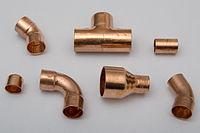
Photo from wikipedia
Abstract Pneumatically conveyed particles are commonly responsible for triggering the erosion process by impacts on the wall. Those impacts result from the fluid-particle interaction and understanding their mechanisms is the… Click to show full abstract
Abstract Pneumatically conveyed particles are commonly responsible for triggering the erosion process by impacts on the wall. Those impacts result from the fluid-particle interaction and understanding their mechanisms is the key to mitigate the erosion damage in engineering applications. In this paper, we propose a novel pipe wall design in order to reduce the erosion on a 90° elbow. This design consists of twisting a pipe wall along the flow streamwise direction. Basically, such configuration generates a swirling flow upstream of the elbow and consequently re-disperses the transported particles, preventing them from focusing on a single point at the elbow. An accurate CFD model based on the Euler-Lagrange approach is used for evaluating the erosion depth. Experimental data on a standard pipe elbow is employed for validating the numerical results. Further, simulations are run for the new pipe geometry. To elucidate the nature of the erosive process on the new pipe wall design, fundamental variables such as impact velocity, impact angle, impact frequency are assessed. In general, the changes in the two-phase flow brought about by the twisted pipe wall are effective for reducing elbow erosion. The simulations show that a reduction of erosion peak up to 33% can be achieved in a pipeline equipped with the twisted pipe wall in comparison to the baseline configuration.